
Station Name: BRAITHWAITE[Source: Alan Young]
Braithwaite Station Gallery 1: c1920 - August 1962
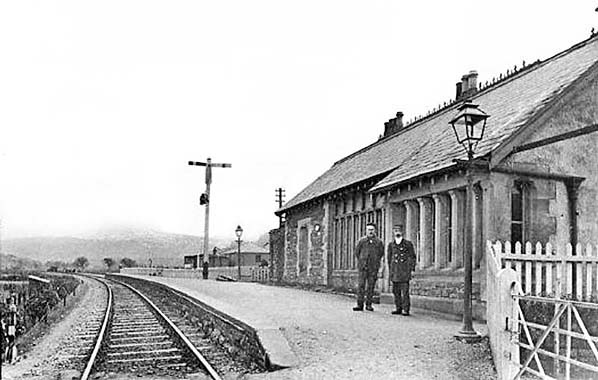 Braithwaite station looking south-east c1920. The single-storey station building, of stone construction, is similar to those at Embleton and some other minor stations on the line. The section in the foreground extends forward to enable station staff in the booking office, behind the mullioned window, to have a good view of the platform. The post carries both up and down signals. At this time a garden is maintained to the left of the rails, but the exuberant display of plants on the platform seen on photos in the 1960s has yet to appear. The ground frame is glimpsed in the left foreground. Braithwaite station looking south-east c1920. The single-storey station building, of stone construction, is similar to those at Embleton and some other minor stations on the line. The section in the foreground extends forward to enable station staff in the booking office, behind the mullioned window, to have a good view of the platform. The post carries both up and down signals. At this time a garden is maintained to the left of the rails, but the exuberant display of plants on the platform seen on photos in the 1960s has yet to appear. The ground frame is glimpsed in the left foreground.Photo from Cumbrian Railway Association  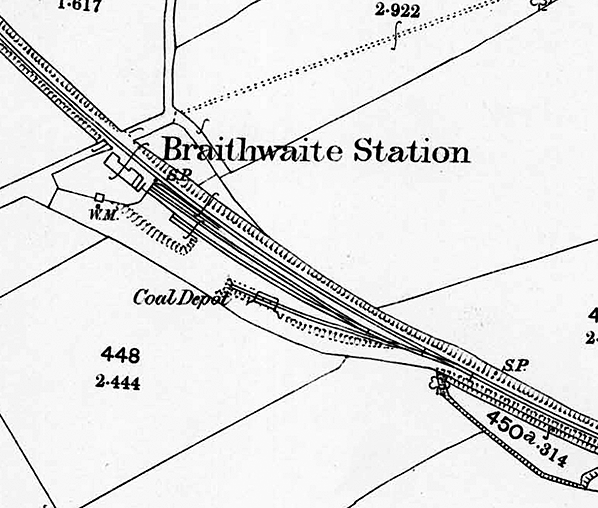
1864 1: 2,500 OS map: The station at Braithwaite is shown soon after it opened. The single platform and modestly-sized station building are south-west of the single-track railway. The goods yard contains three short sidings entered from the down direction, one of them, on an embankment, serving the coal depot. The weigh office (‘W.M.’= weighing machine) is seen close to the road access and the station building.
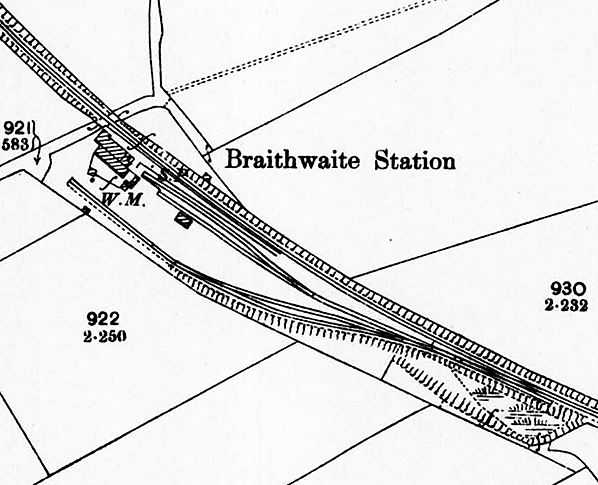
1899 1: 2,500 OS map: Since the map of 1864 the stationmaster’s house has been constructed directly behind the station building and there have been alterations to the layout of the goods yard.
 1925 1: 2,500 OS map: Adjacent fields are now identified as a recreation ground and allotment gardens. A headshunt has been added in the goods yard, extending into what was previously a small patch of marshland. A yard crane (1 ton 10 cwt) is also shown.
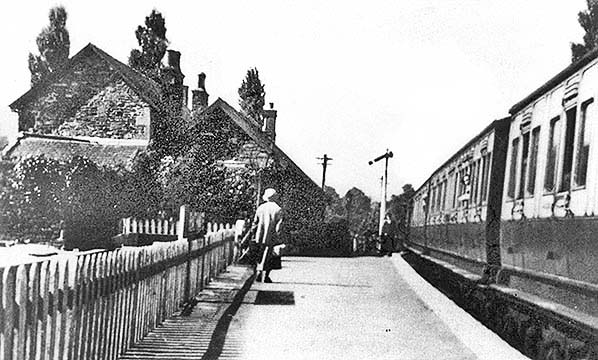
Braithwaite station’s single platform looking north-west c1920s. In the background is the stationmaster’s two-storey house with the single-storey station building in front adjoining the platform. The train, in LNWR ‘plum and spilt milk’ livery, is drawing out of the station towards Bassenthwaite Lake and passing the CK&P starter signal.
Photo by Richard L Pattinson courtesy of Cumbrian Railway Association 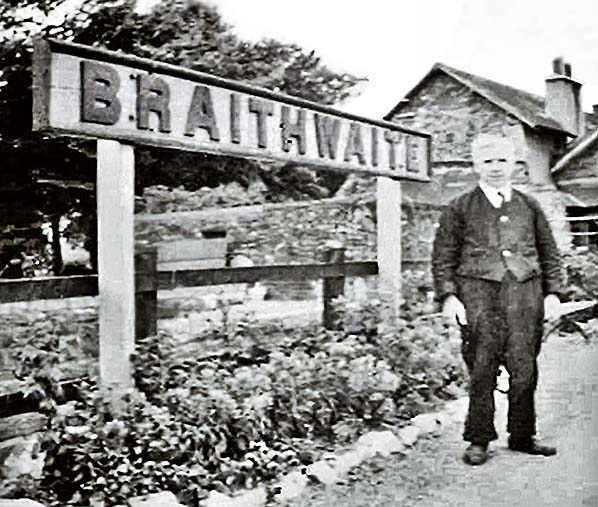 Signalman Fred Askew, was presented with a certificate by the LMS in 1939 in recognition of “the rendering of first aid assistance” at Braithwaite station. A young man had fallen under a train, and while help was sought, Fred treated him on the tracks, attempting to stem the considerable blood loss, comforted and prayed with him and held him in his arms as he died. During the 1926 General Strike, Fred, then an assistant stationmaster, had had rather different dealings with the railway company. As he was liked and trusted by his fellow workers, senior managers exerted pressure to make him break the strike and lead the men back to work. Fred refused and was threatened with demotion if he did not comply. After the strike, he was put to shunting trucks in the snow where he contracted tuberculosis. He later became a signalman until the end of his working life.
Photo from Liz Morfoot 
Braithwaite station looking some time during the LMS days. There is a long rake of rolling stock in the siding the fourth and fifth vehicles from the left are LMS steel-panelled types.
Photo from Cumbrian Railway Association 
What appears to be a busy scene at Braithwaite station in LMS days is actually a still from the 1947 Alfred Hitchcock film The Paradine Case, an American film noir courtroom drama set in England starring Gregory Peck (Anthony Keane) and Ann Todd. In this view Keane is seen arriving at Coniston station on board a train hauled by ex-LNWR 'Cauliflower' No 28580. In the film Braithwaite station was used to depict Coniston station. The loco survived until June 1952 but never carried its allocated BR number 58418.
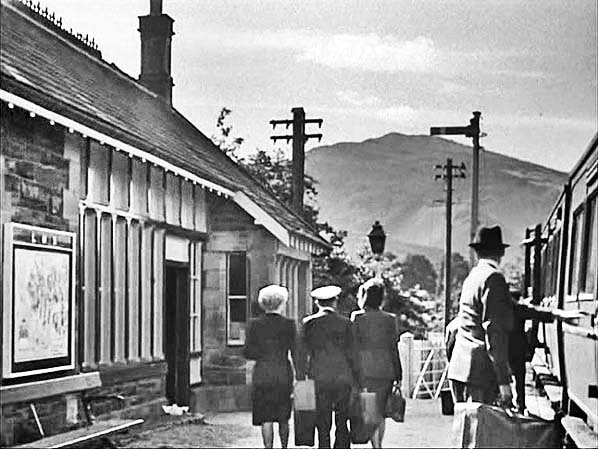 Having disembarked from the train passengers head for the exit.
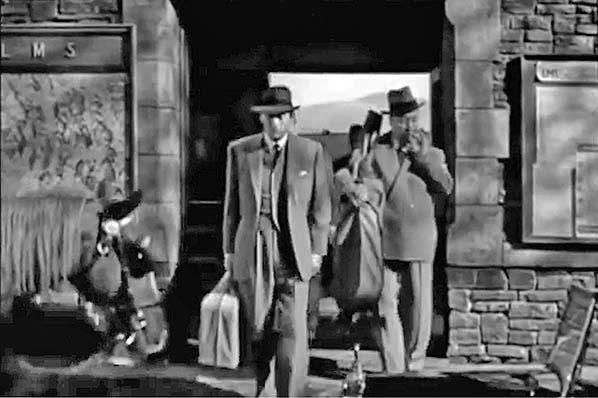 Anthony Keane (Gregory Peck) is seen leaving Braithwaite station. The man to his right carrying a case is Alfred Hitchcock. Hitchcock always gave himself a cameo part in his films. Anthony Keane (Gregory Peck) is seen leaving Braithwaite station. The man to his right carrying a case is Alfred Hitchcock. Hitchcock always gave himself a cameo part in his films.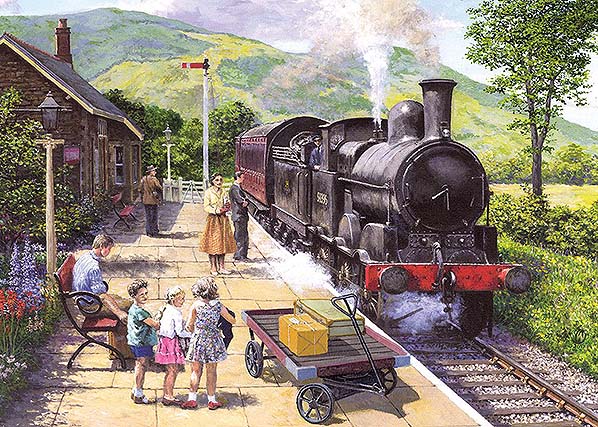 A delightful watercolor depicting Braithwaite station on a summer day in the 1950s with a a Webb Cauliflower 0-6-0 waiting at the platform. The picture is available from the Yorkshire Jigsaw Store as a 1000 piece jigsaw puzzle but is currently out of stock.
Painting by Stephen Warnes 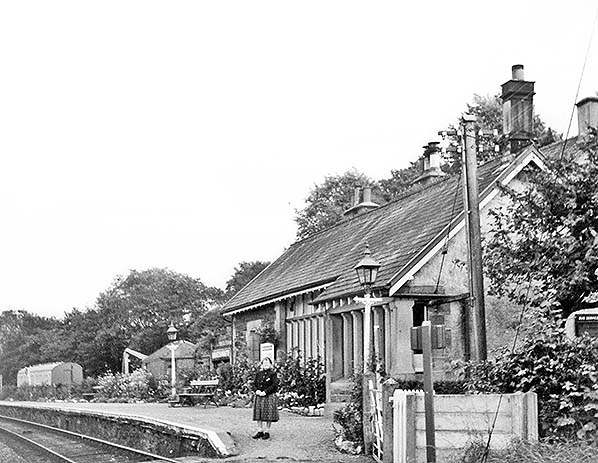
Who is the lady at Braithwaite station? The photo is from October1961 and shows the station at its best with the garden in bloom and a camping coach offering ‘Happy, inexpensive holidays at specially selected Coastal and Inland sites’ (as advertised in BR(NE) summer 1954 timetable). The yard crane is seen to the right of the coaches.
Photo from John Mann collection 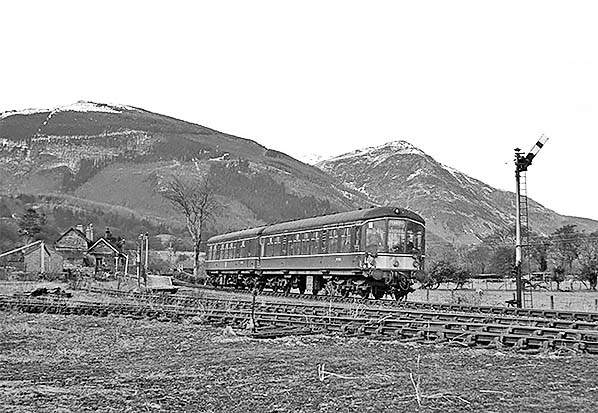
A 2-car Derby Lightweight DMU leaves Braithwaite station bound for Workington in 1961. The sidings on the left look somewhat overgrown and there is no evidence of any use. The yard crane is seen to the left of the station house. The peaks of Barrow (right) and Swinside overlook the station.
Photo from James Lake collection 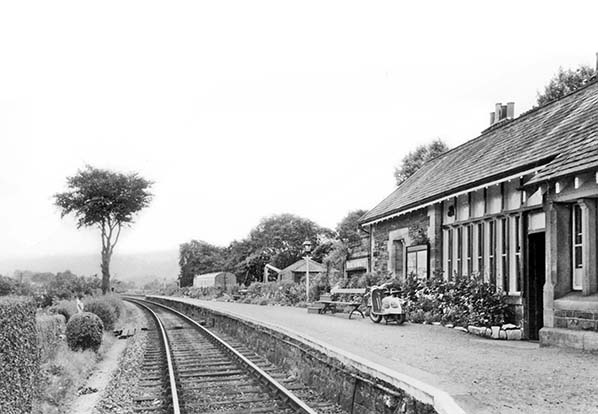 Braithwaite station looking south-east in August 1962. The station garden, developed at track level as well as on the platform, deserves admiration. A camping coach is in place on a siding in the diminutive goods yard.
Copyright photo from Stations UK
|
 Notes: Prior to opening the name of Thornthwaite was considered for this station (announced in a CK&P Board meeting on 4 May 1864) but by 2 June it appears that the name Braithwaite, another nearby village, had been chosen with Mr Richard Hopes appointed as stationmaster. The station was to open with the line on 2 January 1865. There was never a loop at this station which therefore possessed only a single, gently curving platform on the down (south-west) side of the track. Immediately north-west of the platform was a minor level crossing. There was no signal box or gate box although, in time, an unprotected four-lever ground frame was installed to work signals whilst the block instruments were in the station office.
Notes: Prior to opening the name of Thornthwaite was considered for this station (announced in a CK&P Board meeting on 4 May 1864) but by 2 June it appears that the name Braithwaite, another nearby village, had been chosen with Mr Richard Hopes appointed as stationmaster. The station was to open with the line on 2 January 1865. There was never a loop at this station which therefore possessed only a single, gently curving platform on the down (south-west) side of the track. Immediately north-west of the platform was a minor level crossing. There was no signal box or gate box although, in time, an unprotected four-lever ground frame was installed to work signals whilst the block instruments were in the station office. Freight traffic was handled at Braithwaite in a yard behind the platform. In effect there were four short sidings, the two southerly ones forming a loop. Mineral traffic was an important element, with a small warehouse provided in 1866 to lease to the Goldscope Mining Co, followed in 1867 by a coal depot for the use of G I May of the mining company. In 1887 the extension of the warehouse to accommodate the Cumberland Lead Mining Co’s product was approved. Lead and zinc extracted by Thornthwaite Mines Ltd (later styling themselves Threlkeld Lead Mines, Thornthwaite) used the station’s freight facilities; the company was active from 1873 until 1921. Timber was also loaded at Braithwaite. In later CK&P years minor extensions were made to the goods yard layout.
Freight traffic was handled at Braithwaite in a yard behind the platform. In effect there were four short sidings, the two southerly ones forming a loop. Mineral traffic was an important element, with a small warehouse provided in 1866 to lease to the Goldscope Mining Co, followed in 1867 by a coal depot for the use of G I May of the mining company. In 1887 the extension of the warehouse to accommodate the Cumberland Lead Mining Co’s product was approved. Lead and zinc extracted by Thornthwaite Mines Ltd (later styling themselves Threlkeld Lead Mines, Thornthwaite) used the station’s freight facilities; the company was active from 1873 until 1921. Timber was also loaded at Braithwaite. In later CK&P years minor extensions were made to the goods yard layout. 
 From 1 January 1923 at the ‘Grouping’ the line became part of the London, Midland & Scottish Railway (LMS). Under this regime there was little visible change at Braithwaite station, although the LMS installed camping coaches in the goods yard. These redundant passenger coaches were refurbished to provide inexpensive rented accommodation and could be found at many British stations in favoured holiday areas from the 1930s until the early 1960s. Holidaymakers were required to arrive at and depart from the station by train, which assured the railway company of additional revenue.
From 1 January 1923 at the ‘Grouping’ the line became part of the London, Midland & Scottish Railway (LMS). Under this regime there was little visible change at Braithwaite station, although the LMS installed camping coaches in the goods yard. These redundant passenger coaches were refurbished to provide inexpensive rented accommodation and could be found at many British stations in favoured holiday areas from the 1930s until the early 1960s. Holidaymakers were required to arrive at and depart from the station by train, which assured the railway company of additional revenue. 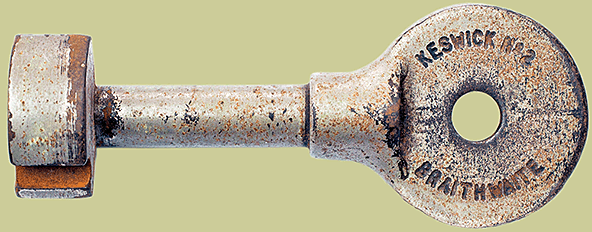
 From 1 January 1948 Braithwaite station was administered by British Railways (BR) London Midland Region (LM).
From 1 January 1948 Braithwaite station was administered by British Railways (BR) London Midland Region (LM).  The station, along with most of the others on the Workington – Penrith line, was fitted with BR(LM) maroon vitreous enamel nameboards, but the complementary ‘totem’ nameplates were not provided at this station; apart from Braithwaite, Embleton and Brigham all of the Penrith-Workington stations received them, probably in the late 1950s, which suggests that Braithwaite was seen as a possible candidate for closure (which did affect Embleton in 1958). No specific threat to Braithwaite at that time has been discovered, but the viability of whole route was assessed in 1959 with a view to possible closure.
The station, along with most of the others on the Workington – Penrith line, was fitted with BR(LM) maroon vitreous enamel nameboards, but the complementary ‘totem’ nameplates were not provided at this station; apart from Braithwaite, Embleton and Brigham all of the Penrith-Workington stations received them, probably in the late 1950s, which suggests that Braithwaite was seen as a possible candidate for closure (which did affect Embleton in 1958). No specific threat to Braithwaite at that time has been discovered, but the viability of whole route was assessed in 1959 with a view to possible closure. The station was never to be demoted to an unstaffed halt but from 1960 staffing was reduced to only one man on each turn of duty. Because Braithwaite was a block post the staff had to be qualified signalmen. Bowtell (1989) gives a vivid description of the responsibilities of one of the staff – Bob Bond – who relieved at the boxes west of Keswick in the early 1960s:
The station was never to be demoted to an unstaffed halt but from 1960 staffing was reduced to only one man on each turn of duty. Because Braithwaite was a block post the staff had to be qualified signalmen. Bowtell (1989) gives a vivid description of the responsibilities of one of the staff – Bob Bond – who relieved at the boxes west of Keswick in the early 1960s: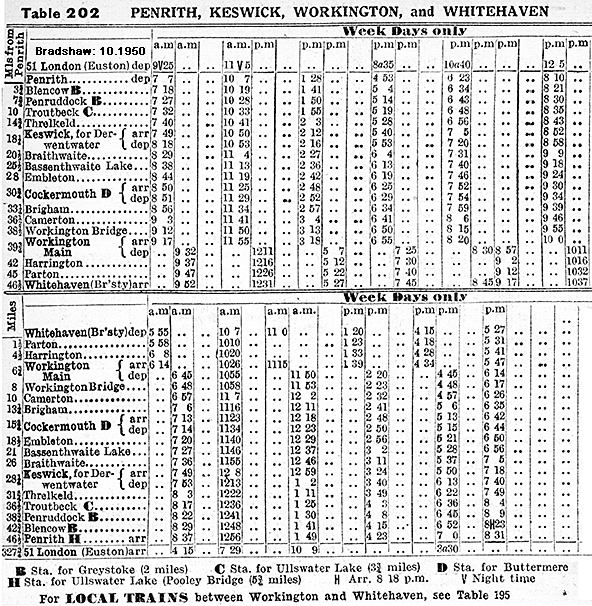
 A proposal to withdraw all passenger services was published on 5 July 1963 and followed the usual TUCC procedure. In late December 1966 Barbara Castle became Minister of Transport and one of her early decisions, announced on 10 January 1966, was that the route should be closed between Workington and Keswick but that the remainder of the line to Penrith should be retained in view of the hardship which would be suffered by users of that section of the route. It seems ironic that Mrs Castle, herself at one time a keen rambler, should have refused closure of some Hope Valley (Derbyshire) stations so that ramblers could use them, whilst approving the closure of Braithwaite and Bassenthwaite Lake stations and the exceptionally scenic stretch of railway between them. The last trains ran between Workington and Keswick on 16 April 1966 and on 18 April Braithwaite station closed. Below is the final list of train departures from Braithwaite.
A proposal to withdraw all passenger services was published on 5 July 1963 and followed the usual TUCC procedure. In late December 1966 Barbara Castle became Minister of Transport and one of her early decisions, announced on 10 January 1966, was that the route should be closed between Workington and Keswick but that the remainder of the line to Penrith should be retained in view of the hardship which would be suffered by users of that section of the route. It seems ironic that Mrs Castle, herself at one time a keen rambler, should have refused closure of some Hope Valley (Derbyshire) stations so that ramblers could use them, whilst approving the closure of Braithwaite and Bassenthwaite Lake stations and the exceptionally scenic stretch of railway between them. The last trains ran between Workington and Keswick on 16 April 1966 and on 18 April Braithwaite station closed. Below is the final list of train departures from Braithwaite.  $ Until 5 September * 17 July until 21 August = 11 July until 29 August ¶ Terminates at Penrith Friday and Saturday 18 June to 4 September ɫ Until 21 August
$ Until 5 September * 17 July until 21 August = 11 July until 29 August ¶ Terminates at Penrith Friday and Saturday 18 June to 4 September ɫ Until 21 August 
 Home Page
Home Page